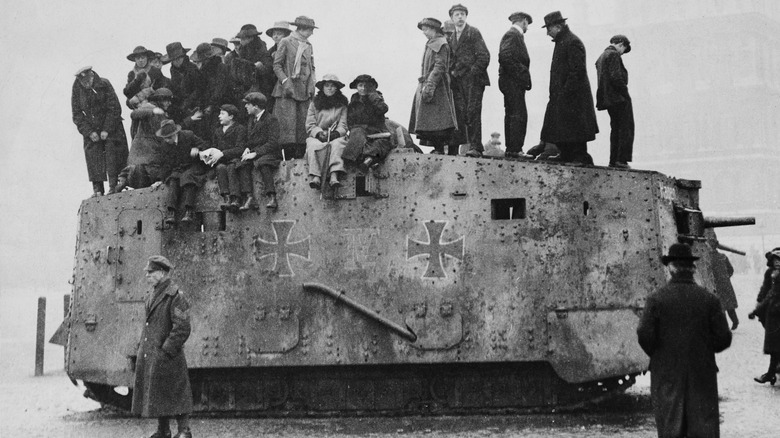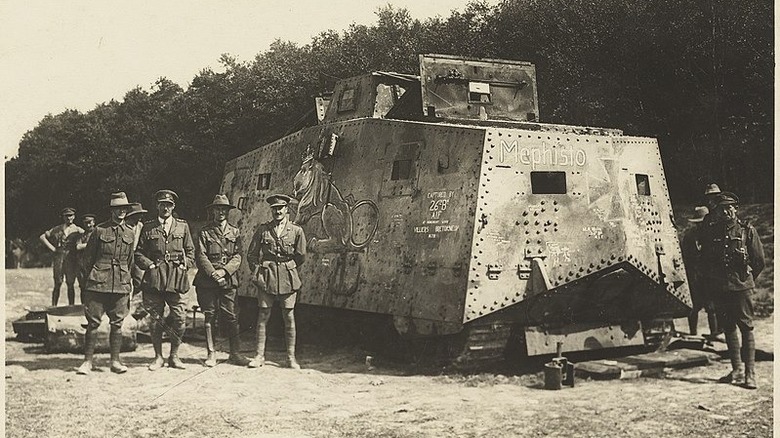The World's Rarest Tank: The History Behind Germany's WW1 A7V Sturmpanzerwagen
Germany's Panzer tank divisions were a scourge that literally ran rings around and through Allied forces during World War II. Feared for their speed and maneuverability, the Panzerkampfwagen was better than Allied tanks. They were a crucial component of the Wehrmacht during the "Blitzkrieg" attacks and provided Adolph Hitler with the means and wherewithal to try and take over the world.
Germany's tank superiority in WWII might lead one to believe they were the innovators of this wartime tech. They were not. Britain actually invented and drove the first Mark I tank onto the battlefield in World War I during the Battle of Flers-Courcelette on September 15, 1916.
In fact, Germany didn't even build a good chunk of its own WWI-era armored vehicles but instead captured and used the enemies. The Sturmpanzerwagen A7V was essentially made because the Germans saw how effective enemy tanks were against them, and the idea of a fully mobile armored fort seething with firepower was simply too much to pass up. The development of the A7V is credited to Joseph Vollmer, a German engineer who owned his own automobile design company. When the war started, he enlisted in the German Army and went on to design not just the A7V but other tanks as well.
Vollmer more or less copied the design of armored train cars from the era. The sides were plated with 30mm armor on the front, 20mm on the rear, and 15mm on the sides. Dimensionally speaking, it was just over 26 feet long, almost 10.5 feet wide, and nearly 11 feet tall.
Not the finest example of German craftsmanship
The tall, oddly shaped, boxy structure was slapped on top of converted track components from a Holt Manufacturing Company tractor (now Caterpillar, makers of the first successful tracked tractor) with fifteen wheels to a side.
The A7V had a main Maxim-Nordenfelt 57 mm gun and six Maxim MG08 machine guns (two on each side and the rear). Oddly, instead of using "new" 57mm guns in the tanks, the Germans scrounged them off the battlefield from abandoned enemy tanks. All of the guns required two soldiers to operate.
Along with a total crew of 18, the A7V carried 30,000 rounds of machine gun ammo and 500 57mm projectiles. There was very little room inside to maneuver, and it was hot and loud. Between the armor plating, crewmembers, and ammunition, the overall weight was a hefty 36 tons. The Sturmpanzerwagen was powered by two Daimler-Benz 4-cylinder engines producing a mere 200 hp with a top speed — on flat surfaces — of a tortoise-like nine mph, which was downright hare-like when compared to the four mph it went over uneven ground.
The German Army ordered 100, but ultimately only 20 were made. Building them was both slow and expensive. Those that did clank onto the battlefield were plagued with problems. The narrow track base and top-heavy design made the A7V unsteady on rough terrain. The powertrain was unreliable and broke down often. Plus, the slow, lumbering beast had huge sides that made it an easy target.
The (only) one that got away
Each of the finished tanks was given names by their individual crews, like "Nixe," "Gretchen," "Faust," "Prinz Oskar," and "Mephisto," among others. In late April of 1918, near the French town of Villers-Bretonneux, the Sturmpanzerwagen made its mark on history. Thirteen of the A7Vs, including "Nixe" and "Mephisto," were involved in the world's first tank-to-tank battle when they went head-to-head against twelve British Mark IV tanks.
When all was said and done, six of the British tanks were damaged in the scuffle. Two of the German tanks broke down, and the "Nixe" was so badly damaged that the crew jumped ship before all the ammo exploded. The "Mephisto" was also abandoned after the heavy tank fell into a shell crater and couldn't escape.
It sat in that hole for more than two months, until July 1918, when soldiers from the 26th Battalion of the Australian Infantry Battalion (made up mostly of soldiers from Queensland, Australia) were able to take back the area and, in the middle of the night, moved the Sturmpanzerwagen to safety.
While eighteen of the original 20 A7Vs survived the war, all but one were demilitarized and scrapped after the Armistice was signed on November 11, 1918. The one that did survive was the "Mephisto." In 1919, it was shipped to Australia as a spoil of war and has been on exhibit at the Queensland Museum in Brisbane since.

